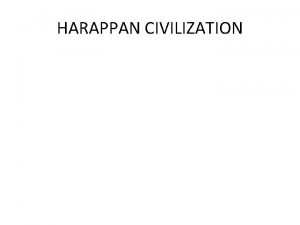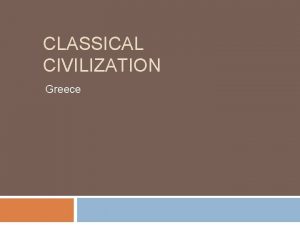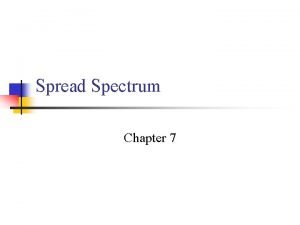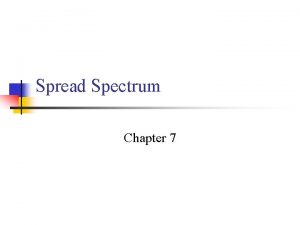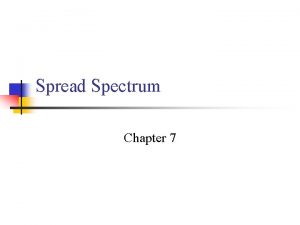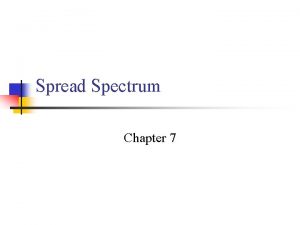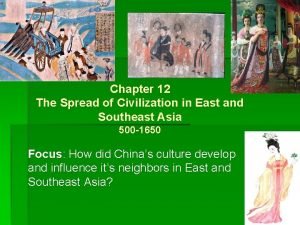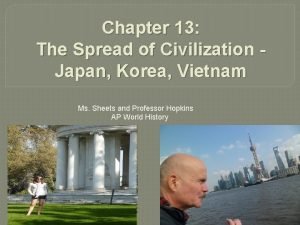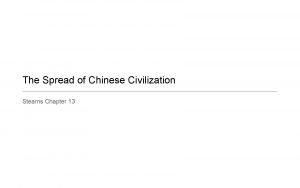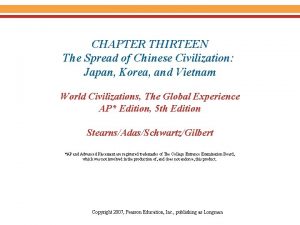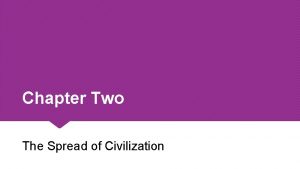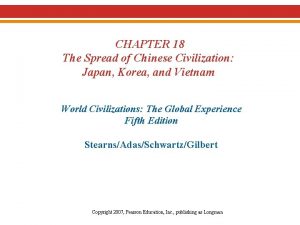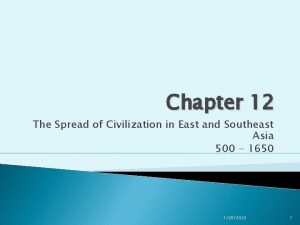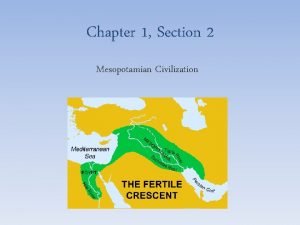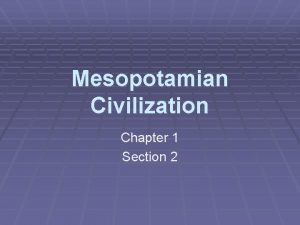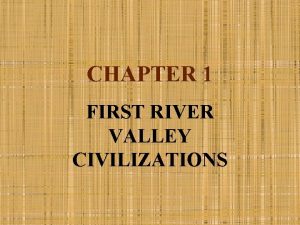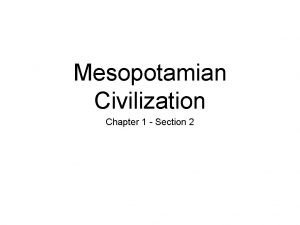Chapter 2 The Spread of Civilization Sections 1




































- Slides: 36

Chapter 2: The Spread of Civilization Sections 1 -3

Egyptian Geography Nile River World’s longest river: 4, 000 miles Predictable flooding Provided natural irrigation and carried silt Egypt would be a complete desert without the Nile Public work projects: dikes, reservoirs, and irrigation ditches channeled the flood waters Nile flowed from South to North Delta- triangular area of marshland formed by deposits of silt


Egypt’s Natural Defenses Desert protected Egypt from external invasions from east and west Cataracts (waterfalls) provided a buffer against invasions from south Mediterranean Sea protected from North Egypt became isolated


Egypt’s Religion Polytheistic Sun, land, and river gods Emphasized unification Happy afterlife for the virtuous Amon-Re: Chief and universal god Osiris: God of the Nile Controlled flooding and made land fertile Anubis: Supervised the weighing of souls at judgment


Mummification Cornerstone of Egyptian faith Prepared their dead for the afterlife through a preservation process called mummification Embalming and wrapping them in cloth At first: only rulers and nobles were mummified Eventually it became available for all Pyramids- elaborate tombs


Social Class

Course of Egyptian History Historians divided history of ancient Egypt into three periods: Old, Middle, and New Kingdoms Power passed from one dynasty (ruling family) to another Menes- king of Upper Egypt- united Upper and Lower Egpyt around 3100 BCE. Founded Egypt’s first capital- Memphis

Old Kingdom (27002200 BCE) Pharaohs (kings) grew in power Kings were recognized as gods Had absolute power Role of the king was to maintain law and order: ma’at Bureaucracy- a system of government that includes different job functions and levels of authority Had 42 governors who provided power Vizier- chief minister- supervised business of government Built pyramids for afterlife; Necropolises Great Sphinx at Giza and Khufu’s Great Pyramid: two great achievements Decline: power struggle and crop failure; cost of building pyramids

Middle Kingdom (20501750 BCE) “Golden Age” Egypt expanded into Nubia; led to trade with Kush, Syria, and Mesopotamia Trade revived and arts flourished Had stronger state organization Pharaoh is thought of as a shepherd Introduced bronze, horses, and chariots Decline: foreign invaders called Hyksos occupied the Nile area

New Kingdom (15501050 BCE) New militarism: powerful and ambitious pharaohs Moved into Palestine and Syria Palaces, temples, as focal points of unity and government Decline: frequent rebellions, defeats, Nubia gained independence

Hatshepsut (1473 -1458 BCE) Daughter of Thutmosis I Took over for young stepson: ruled in his name because he was too young Declared herself as pharaoh Encouraged trade with eastern Mediterranean lands

Women in Egypt Could own property Enter business deals Get a divorce Education was not permitted Could be pharaoh Husband was still considered master of house

Contributions Science and Math Mummy process- learn about human body; diagnosis illnesses Complex surgical procedures Developed calendar with 12 months and 30 days each Developed math to calculate flooding calendar Pyramids and temples

Contributions Hieroglyphics- picture writing Hieratic writing- simpler script for everyday use Created a bureaucracy Learned how to make paper- papyrus Art: Temples, monuments, pyramids, statues The Sphinx- man-lion


Section 2: Peoples in the Eastern Mediterranean

Nomadic Peoples Outside of major river civilizations people were still nomads Pastoral Nomads- a person who domesticates animals for food and clothing and moves along river migratory routes Indo-Europeans- most significant nomadic peoples Language was a mix of: Greek, Latin, Persian, Sanskrit, and Germanic Formed Hittite Kingdom in Asia; capital is Hattushash

Phoenicians Lived near the Mediterranean Sea When the Egyptian and Hittite Kingdoms collapsed, Phoenicians took over Trade made Phoenicians prosperous Created one of the first alphabets with 22 characters

Israelites lived south of the Phoenicians Settled in Judaism religion Much of the Israelites’ history and religious beliefs were eventually written in the Bible (Old Testament) Israelites- descendants of Abraham Drought forced Israelites to move to Egypt where they were enslaved until Moses led them out Under King David- Israelites established control over the land that is currently known as Israel

Division of Israelites In 722 - Assyrians overran the kingdom of Israel

Judaism Monotheistic- belief in one God- creator of the world and everything in it Jews think God rules the world and all people are his servants Covenant, law, and prophets are three aspects of the religion Ten Commandments Prophets- religious teachers

Indus Valley

Geography Indian subcontinent is shaped like a triangle Subcontinent: large landmass that juts out from a continent Geographic features: Himalayas- largest mountains in world Hindu Kush- mountain ranges in the north west Mountains- limited contacts with other land which leaves a distinct culture in India Rich valley- Ganges Indus River Valley is in currently in Pakistan Deccan- hilly, dry, and sparsely populated

Monsoons Seasonal winds that regularly blow from a certain direction for part of the year October- winter monsoons blow from the northeast, bringing hot dry air Mid-June: summer monsoons Pick up moisture from the Indian Ocean and carry it to the land People welcomed the rain; no rain meant there would be famine

Mohenjo-Daro and Harappa Major cities that flourished in the Indus River Valley 35, 000 -40, 000 Well planned cities with main streets, walled neighborhoods, public wells Revels an organized government

Indus River Government Rulers based their power on a belief in divine assistance Economy based on farming Trade was between Mesopotamia Polytheistic-possibly animism Venerated cattle Do not know too much about the Indus River because we cannot translate their writings

Decline of the Indus River Valley Not sure as to why Could have been a change in climate Major flooding or earthquake Probably not one single cause Invasion of Aryans

Aryans Migrate into India By 1500 BCE- nomadic and warlike people called Aryans came into India Spoke a language from the Indo-Europeans Most of what we know has come from the Vedascollection of hymns, chants, and religious instructions Priests memorized and spoke the Vedas for many years before they were written down 1500 -500 BCE is called Vedic Age This became the basis of Hinduism

Aryan Way of Life Settled into villages and learned how to farm Iron plow and irrigation helped them to turn the Ganges into farmland Developed a writing system: Sanskrit Aryan tribes were led by chiefs called rajas- skilled war leader

Caste System From the Vedas, Aryans divided their society into ranked groups based on occupation This is known as the caste system Set rigid categories Based on the color of the skin Castes determined a person’s economic, social, and religious status

Family in Ancient India Family was the basic unit in Indian life 3 generations would live together Patriarchal: only males could own property and educated Women married young Sati- women who would throw themselves in a fire upon husbands death

Religious Beliefs Polytheistic Gods were based on natural forces: sky, sun, storm, fire Chief Aryan god: Indra
 Chapter 9 conic sections and analytic geometry
Chapter 9 conic sections and analytic geometry How many sections are in the chapter handbook for tx hosa?
How many sections are in the chapter handbook for tx hosa? Chapter 7 conic sections and parametric equations
Chapter 7 conic sections and parametric equations Chapter 9 conic sections and analytic geometry
Chapter 9 conic sections and analytic geometry Chapter 16 lesson 1 the protestant reformation
Chapter 16 lesson 1 the protestant reformation Hình ảnh bộ gõ cơ thể búng tay
Hình ảnh bộ gõ cơ thể búng tay Ng-html
Ng-html Bổ thể
Bổ thể Tỉ lệ cơ thể trẻ em
Tỉ lệ cơ thể trẻ em Chó sói
Chó sói Tư thế worm breton
Tư thế worm breton Hát lên người ơi
Hát lên người ơi Các môn thể thao bắt đầu bằng tiếng nhảy
Các môn thể thao bắt đầu bằng tiếng nhảy Thế nào là hệ số cao nhất
Thế nào là hệ số cao nhất Các châu lục và đại dương trên thế giới
Các châu lục và đại dương trên thế giới Cong thức tính động năng
Cong thức tính động năng Trời xanh đây là của chúng ta thể thơ
Trời xanh đây là của chúng ta thể thơ Cách giải mật thư tọa độ
Cách giải mật thư tọa độ Phép trừ bù
Phép trừ bù độ dài liên kết
độ dài liên kết Các châu lục và đại dương trên thế giới
Các châu lục và đại dương trên thế giới Thể thơ truyền thống
Thể thơ truyền thống Quá trình desamine hóa có thể tạo ra
Quá trình desamine hóa có thể tạo ra Một số thể thơ truyền thống
Một số thể thơ truyền thống Cái miệng nó xinh thế chỉ nói điều hay thôi
Cái miệng nó xinh thế chỉ nói điều hay thôi Vẽ hình chiếu vuông góc của vật thể sau
Vẽ hình chiếu vuông góc của vật thể sau Nguyên nhân của sự mỏi cơ sinh 8
Nguyên nhân của sự mỏi cơ sinh 8 đặc điểm cơ thể của người tối cổ
đặc điểm cơ thể của người tối cổ Ví dụ giọng cùng tên
Ví dụ giọng cùng tên Vẽ hình chiếu đứng bằng cạnh của vật thể
Vẽ hình chiếu đứng bằng cạnh của vật thể Tia chieu sa te
Tia chieu sa te Thẻ vin
Thẻ vin đại từ thay thế
đại từ thay thế điện thế nghỉ
điện thế nghỉ Tư thế ngồi viết
Tư thế ngồi viết Diễn thế sinh thái là
Diễn thế sinh thái là Dot
Dot









































